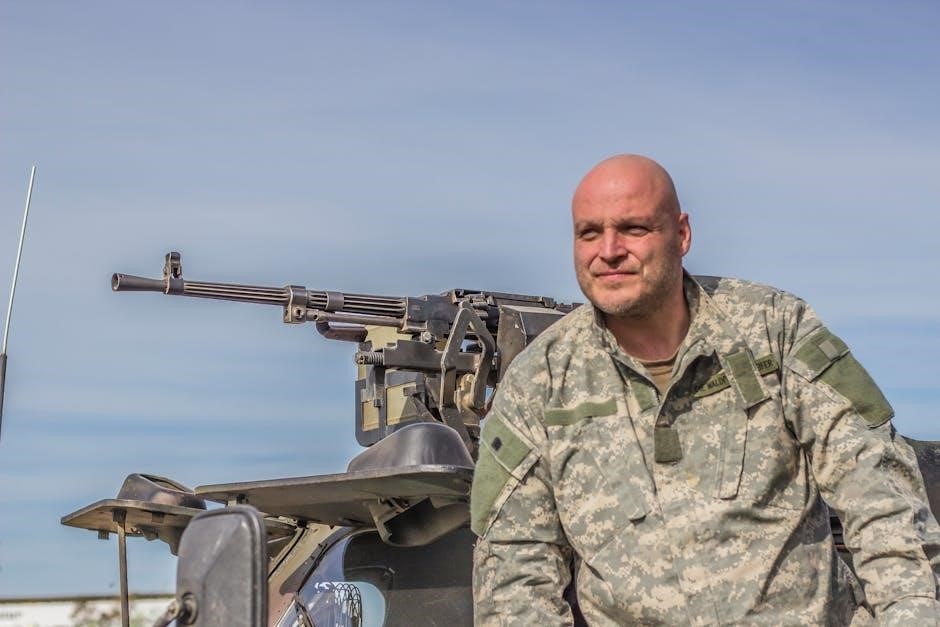Land warfare armored tactics involve the strategic deployment of armored vehicles to achieve decisive outcomes on the battlefield. This approach combines speed, protection, and firepower to overwhelm enemy defenses, leveraging historical lessons and modern technological advancements to maximize effectiveness in various combat scenarios.
Overview of Land Warfare
Land warfare encompasses military operations conducted on land, involving diverse combat skills, weapon systems, and terrain. It integrates armored vehicles, infantry, and artillery to achieve strategic objectives. Armored tactics play a crucial role, emphasizing mobility, protection, and firepower to break enemy defenses. Modern land warfare adapts to evolving threats, leveraging advanced technologies like C4ISR systems and precision weaponry. Terrain and weather significantly influence operations, requiring adaptable strategies. Coordination between armored and infantry units is essential for successful missions. Historical developments, such as blitzkrieg and mechanized infantry, highlight the importance of maneuver and surprise; Effective logistics and maintenance ensure armored units remain operational, underscoring their critical role in contemporary land warfare.
Evolution of Armored Warfare
Armored warfare has undergone significant transformations since its inception in World War I. Initially, tanks were deployed to breach trench defenses, relying on brute force. World War II saw advancements in tank design, tactics, and coordination with air and infantry forces, epitomized by the German blitzkrieg. The Cold War era introduced mechanized infantry, enhancing mobility and combined arms operations. Modern armored warfare integrates advanced technologies such as reactive armor, precision-guided munitions, and C4ISR systems, enabling real-time command and control. These developments have shifted armored tactics from brute force to strategic maneuver, emphasizing speed, surprise, and coordination. The evolution reflects continuous adaptation to battlefield challenges and technological progress.
Key Principles of Armored Tactics
Armored tactics rely on several core principles to ensure effective battlefield execution. Maneuver warfare emphasizes speed and surprise to outflank and disrupt enemy formations. Combined arms integration synchronizes armor with infantry, artillery, and air support, enhancing operational synergy. Shock tactics aim to overwhelm enemy morale through decisive strikes. Coordination between armored and supporting units is crucial for maintaining momentum and exploiting weaknesses. Logistics and maintenance ensure operational readiness, enabling sustained campaigns. These principles, honed through historical conflicts, form the foundation of modern armored doctrine, balancing firepower, mobility, and adaptability to achieve strategic objectives in diverse combat environments while minimizing vulnerabilities.
Historical Development of Armored Tactics
Armored tactics evolved from early cavalry strategies to integrate tanks and mechanized infantry, revolutionizing land warfare through enhanced mobility and firepower over the 20th century.
World War I: The Birth of Tank Warfare
World War I marked the debut of tank warfare, with armored vehicles introduced to break the stalemate of trench warfare. Initially, tanks were slow and unreliable but provided crucial cover for infantry, enabling breakthroughs in static battlefields. Their deployment demonstrated the potential of armored forces to restore mobility to warfare. Early tanks faced mechanical challenges and limited coordination with infantry, yet their psychological impact on enemy forces was significant. This innovation laid the foundation for future developments in armored tactics, reshaping military strategy and paving the way for modern mechanized warfare. The integration of tanks in World War I signified a radical shift in land warfare methodologies.
World War II: Advancements in Armored Tactics
World War II witnessed transformative advancements in armored tactics, driven by the widespread adoption of tanks and mechanized forces. The German Blitzkrieg strategy exemplified the integration of armored divisions with air support, achieving rapid territorial gains through surprise and speed. Tanks evolved significantly, with improvements in mobility, firepower, and armor. The war also saw the development of combined arms doctrine, where armor, infantry, and artillery coordinated to maximize battlefield effectiveness. Additionally, the introduction of new technologies, such as tank radios and anti-tank weapons, further refined armored warfare. These innovations addressed the limitations of early tank warfare and set the foundation for modern armored tactics, emphasizing mobility, coordination, and overwhelming force.
Cold War Era: The Rise of Mechanized Infantry
The Cold War era marked a significant shift in armored tactics with the emergence of mechanized infantry. This period saw the integration of infantry units with armored vehicles, enhancing their mobility and combat effectiveness. Tanks became more specialized, with main battle tanks like the M60 Patton and T-62 dominating the battlefield. The development of anti-tank missiles and guided weapons necessitated new tactics, such as dispersed formations and combined arms strategies. Mechanized infantry units were trained to operate in coordination with armor, emphasizing rapid deployment and sustained combat operations. This era also highlighted the importance of logistics and maintenance, ensuring armored units remained operational in prolonged conflicts. These advancements laid the groundwork for modern armored warfare, where infantry and armor function as a cohesive force.
Modern Era: Technological Advancements in Armored Warfare
The modern era has witnessed transformative technological advancements in armored warfare, enhancing the lethality, survivability, and operational efficiency of armored units. Active Protection Systems (APS) now intercept anti-tank missiles, while advanced composite armor provides superior protection against precision-guided munitions. Network-centric warfare enables real-time data sharing, allowing tanks to operate as part of integrated combat teams. Autonomous systems and AI-driven targeting platforms are being integrated, reducing human error and accelerating decision-making. Modern propulsion systems offer greater mobility and endurance, while unmanned ground vehicles (UGVs) are being tested for reconnaissance and logistics. These innovations ensure armored forces remain dominant on the contemporary battlefield, adapting to emerging threats and complexities.
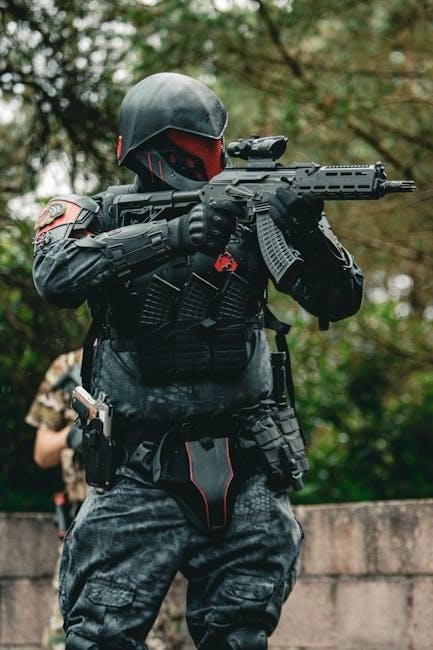
Core Principles of Armored Tactics
Armored tactics emphasize maneuver warfare, combined arms integration, and shock action to disrupt enemy formations. These principles enhance operational effectiveness in modern battlefield scenarios.
Maneuver Warfare: Speed and Surprise
Maneuver warfare relies on exploiting speed and surprise to disrupt enemy formations and create strategic advantages. Armored units leverage rapid deployment and unpredictable movements to outflank opponents, maximizing operational tempo. Historical examples, such as Blitzkrieg tactics in WWII, demonstrate how surprise attacks and swift armored advances can overwhelm defenses. Modern armored forces emphasize mobility and agility, enabling them to strike at vulnerable points before enemies can react. This approach minimizes prolonged engagements, reduces casualties, and achieves decisive outcomes. By integrating advanced technologies, armored units enhance their ability to execute maneuver warfare effectively, ensuring superiority on the battlefield. Speed and surprise remain cornerstone principles in contemporary armored tactics.
Combined Arms: Integration of Infantry and Armor
Combined arms tactics integrate infantry and armored units to achieve enhanced combat effectiveness. This synergy leverages the strengths of both forces, with armor providing firepower and mobility, while infantry offers versatility and situational awareness. Historical examples, such as WWII operations, demonstrate how coordinated efforts between tanks and foot soldiers maximized battlefield impact. Modern strategies emphasize seamless communication and synchronized movements, ensuring mutual support. Advanced technologies, like C4ISR systems, further enhance this integration, enabling real-time coordination. The fusion of infantry and armor creates a formidable force, capable of overcoming diverse challenges while minimizing vulnerabilities. This approach remains central to contemporary land warfare doctrine, ensuring adaptability and lethality in dynamic combat environments.
Shock Tactics: Breaking Enemy Morale
Shock tactics are designed to disrupt enemy cohesion through rapid, overwhelming attacks, primarily utilizing armored forces to create psychological and physical impact. This approach aims to shatter morale, causing disorganization and retreat. Historically, armored units like German Panzer divisions in WWII employed Blitzkrieg, combining speed and firepower to devastating effect. Modern shock tactics integrate advanced technologies, such as precision strikes and real-time intelligence, to amplify their effectiveness. The sudden deployment of heavily armored vehicles, supported by air and artillery, creates an unstoppable force that overwhelms defenses. By targeting command structures and key positions, shock tactics destabilize enemy operations, fostering confusion and paralysis. This method remains a cornerstone of offensive strategies, ensuring rapid dominance on the battlefield.

Key Components of Armored Units
Armored units rely on coordination between vehicles and infantry, robust logistics, and advanced vehicle capabilities to ensure mobility, firepower, and survivability in dynamic combat environments.
The Role of Armored Vehicles in Modern Warfare
Armored vehicles are central to modern land warfare, providing mobility, protection, and firepower. They enable rapid deployment across diverse terrains, breaking through enemy defenses and delivering precision strikes. Modern tanks and armored fighting vehicles are equipped with advanced weaponry, such as anti-tank missiles and machine guns, to dominate the battlefield. Their armor plating protects crews from enemy fire, ensuring survivability in high-intensity conflicts. Additionally, these vehicles facilitate the transport of infantry, enhancing combined arms operations. The integration of technologies like reactive armor and active protection systems further elevates their effectiveness. Armored vehicles remain a cornerstone of modern military strategy, ensuring tactical superiority and operational flexibility in contemporary warfare scenarios.
Coordination Between Armored and Infantry Units
Effective coordination between armored and infantry units is crucial for achieving tactical success. Armored vehicles provide the necessary firepower and mobility, while infantry ensures versatility and situational awareness. Combined arms tactics integrate these elements, allowing for synchronized operations that exploit enemy weaknesses. Armored units can breach defensive lines, creating openings for infantry to secure key positions. Conversely, infantry can neutralize anti-tank threats, safeguarding armored assets. Real-time communication and shared situational awareness are essential for seamless coordination. This synergy maximizes combat effectiveness, enabling forces to adapt to dynamic battlefield conditions and achieve strategic objectives efficiently. Proper training and doctrine are vital to ensure these units operate cohesively, enhancing overall mission success in modern warfare scenarios.
Logistics and Maintenance in Armored Warfare
Logistics and maintenance are critical to the success of armored warfare, ensuring the operational readiness of armored vehicles. A reliable supply chain for fuel, ammunition, and spare parts is essential to sustain armored units in the field. Maintenance crews must perform routine repairs and diagnostics to prevent mechanical failures, while armored vehicles require constant upkeep to withstand combat conditions. Effective logistics also involve the rapid transportation of supplies to forward operating bases, ensuring uninterrupted operations. Without robust logistical support, armored units risk losing mobility and combat effectiveness. Proactive maintenance practices, including scheduled overhauls and crew training, are vital to maintaining the integrity of armored forces. Modern diagnostic tools and simulation systems further enhance maintenance efficiency, ensuring tanks remain battle-ready at all times.
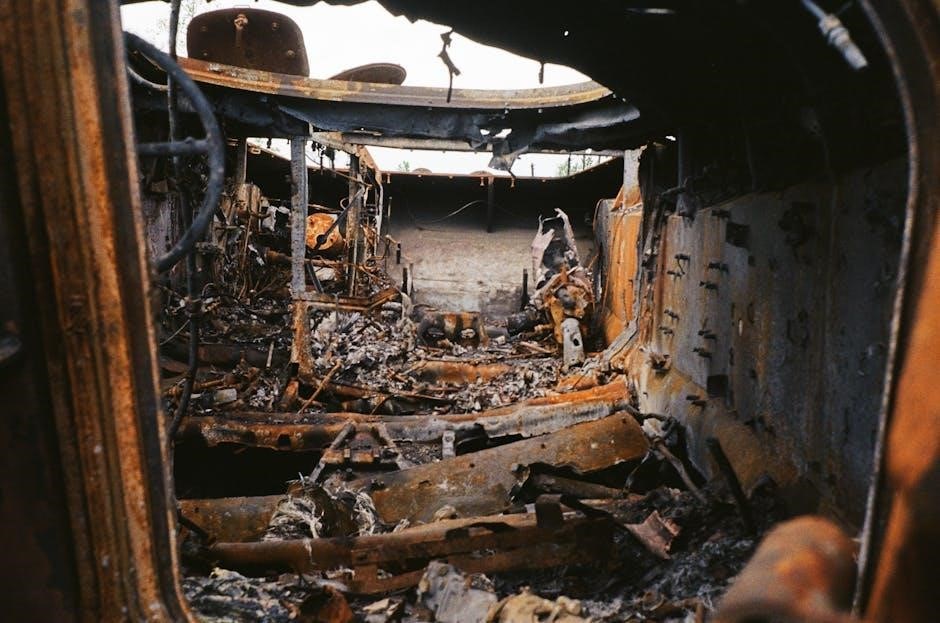
Role of Technology in Armored Warfare
Technology enhances armored warfare by improving vehicle survivability, lethality, and situational awareness. Advances like reactive armor, active protection systems, and precision-guided munitions redefine modern battlefield capabilities, ensuring superior performance.
Modern Technologies in Armored Vehicles
Modern technologies in armored vehicles have revolutionized land warfare, enhancing survivability, lethality, and operational efficiency. Advanced systems like reactive armor and active protection systems counter anti-tank missiles and improvised explosive devices. Thermal imaging, laser rangefinders, and AI-driven targeting systems improve situational awareness and precision. Network-centric warfare enables real-time data sharing between units, fostering coordinated maneuvers. Unmanned ground vehicles and autonomous systems reduce crew exposure to threats. Additive manufacturing expedites production of spare parts, ensuring readiness. These innovations ensure armored forces remain dominant on the battlefield, adapting to evolving threats and operational demands effectively.
C4ISR Systems: Command, Control, Communications, Computers, Intelligence, Surveillance, and Reconnaissance
C4ISR systems are integral to modern armored tactics, enabling seamless integration of command, control, and intelligence. These systems enhance situational awareness by providing real-time data from various sensors and platforms. Advanced communication networks ensure rapid information sharing between units, facilitating synchronized operations. Intelligence gathering through surveillance and reconnaissance assets identifies enemy positions and vulnerabilities. Computers process vast amounts of data, supporting decision-making. Together, these systems optimize mission execution, improve combat effectiveness, and ensure superior coordination in dynamic battlefield environments, making them indispensable for contemporary land warfare strategies.
Simulation Training for Armored Units
Simulation training is a cornerstone of modern armored unit preparedness, offering immersive and realistic environments for soldiers to hone their skills. Advanced simulators replicate complex battlefield scenarios, allowing crews to practice tactics, coordination, and decision-making without the risks of live exercises. These systems incorporate real-world terrain data, enemy behaviors, and weapon systems to enhance authenticity. Simulation also enables the testing of new strategies and the analysis of performance metrics, fostering continuous improvement. By reducing costs and logistical challenges, simulation training ensures that armored units maintain peak readiness, adaptability, and effectiveness in diverse operational contexts, making it essential for contemporary military training doctrine.
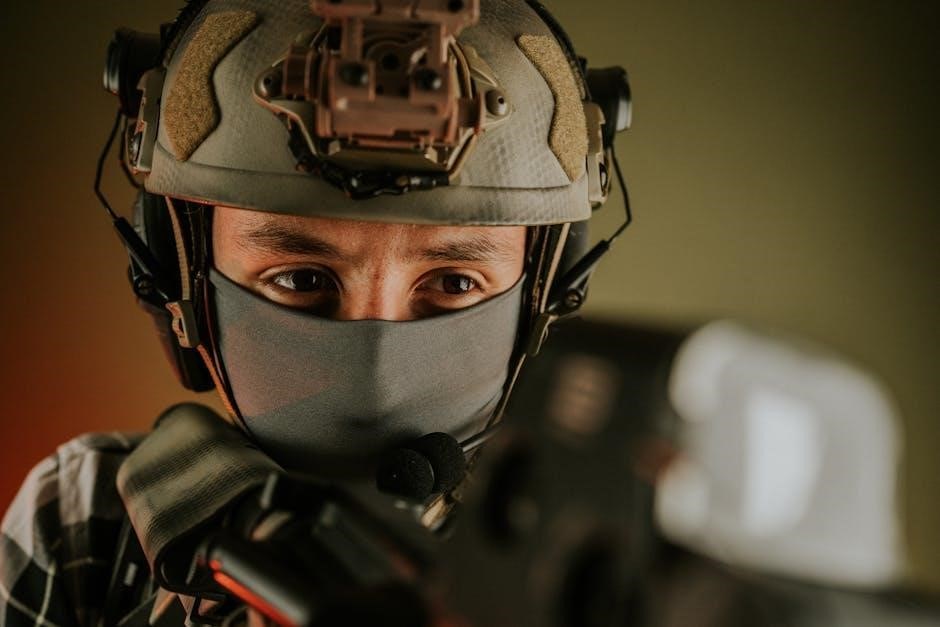
Strategic and Doctrinal Shifts
Strategic and doctrinal shifts in land warfare emphasize adapting tactics to modern threats, integrating technology, and enhancing coordination between armored and infantry units for effective battlefield outcomes.
Evolution of Military Doctrine in Land Warfare
The evolution of military doctrine in land warfare reflects changing strategies to address new threats and technologies. Earlier doctrines emphasized static defenses, while modern approaches prioritize mobility and combined arms integration. The shift from trench-based warfare in World War I to the rapid maneuvers of World War II demonstrated this transformation. Post-war, the Cold War era saw the rise of mechanized infantry and armored units, with a focus on deterrence and flexible response strategies. Contemporary doctrines now incorporate advanced technologies like C4ISR systems and simulation training, ensuring adaptability to asymmetric threats and urban warfare challenges, while maintaining the core principles of speed, surprise, and coordination.
Operational Lessons from Historical Conflicts
Historical conflicts have provided invaluable lessons for modern land warfare tactics. World War I demonstrated the necessity of armored vehicles to break trench stalemates, while World War II highlighted the effectiveness of combined arms and rapid maneuver. The Gulf War showcased the dominance of advanced weaponry and precision strikes. These conflicts underscored the importance of coordination between armored and infantry units, as well as the need for adaptable strategies in diverse terrains. Urban warfare scenarios revealed the challenges of operating in densely populated areas, emphasizing the need for precision and minimized collateral damage. These lessons continue to shape contemporary doctrines, ensuring armored tactics remain effective in evolving battlefield conditions.
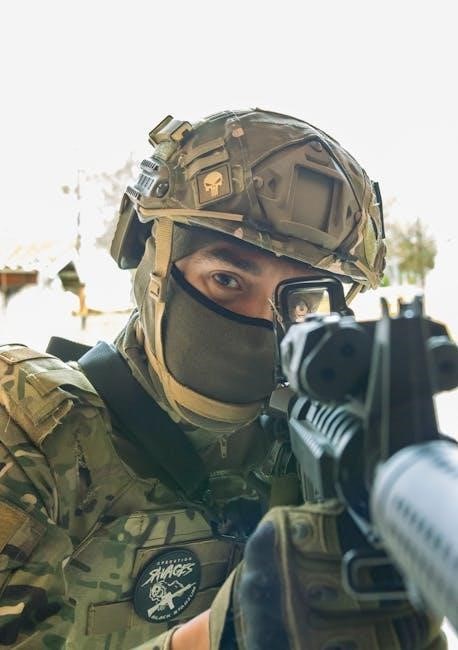
Case Studies in Armored Tactics
Case studies reveal the evolution and effectiveness of armored tactics in historical conflicts, such as Blitzkrieg in World War II and armored operations in the Gulf War.
Blitzkrieg: The German Approach in World War II
Blitzkrieg, or “lightning war,” was a revolutionary German military strategy in World War II, emphasizing speed, surprise, and overwhelming force. It combined concentrated armored divisions, air support, and infantry to rapidly break through enemy defenses. This tactic bypassed traditional linear warfare, focusing on deep penetration and encirclement to disrupt command structures and morale. The effectiveness of Blitzkrieg lay in its ability to exploit weaknesses and create chaos, leading to swift territorial gains. It fundamentally altered modern warfare by showcasing the potency of armored mobility and coordination, making it a cornerstone of future military doctrine and a defining feature of World War II battles.
The Gulf War: Coalition Armored Operations
The Gulf War showcased the effectiveness of Coalition armored operations, leveraging advanced technology and strategic coordination. Coalition forces utilized superior air power and precision-guided munitions to decimate Iraqi armored units. The M1 Abrams tank and other armored vehicles demonstrated exceptional survivability and lethality, dominating the battlefield. Rapid maneuver warfare allowed Coalition forces to outflank and encircle Iraqi positions, leading to swift territorial gains. The integration of armored units with infantry and air support highlighted the importance of combined arms tactics. This conflict underscored the significance of technological superiority, strategic planning, and operational coordination in modern armored warfare, setting a benchmark for future military operations.
Urban Warfare: Armored Tactics in City Environments
Urban warfare presents unique challenges for armored tactics, requiring adapted strategies to navigate densely populated areas. Armored vehicles must operate in narrow, unpredictable environments, often facing ambushes and improvised explosive devices. Coordination between armor and infantry is crucial, as tanks provide cover while infantry clears buildings and neutralizes threats. Precision is key to minimize civilian casualties and collateral damage. Modern armored vehicles are equipped with advanced sensors and communication systems to enhance situational awareness in urban settings. Urban warfare demands a balanced approach, combining firepower, maneuverability, and tactical finesse to maintain control and protect non-combatants. These operations highlight the evolving role of armor in asymmetric conflicts.

Contemporary Challenges in Armored Warfare
Modern armored warfare faces challenges like asymmetric threats, urban combat, and advanced countermeasures, requiring adaptive tactics and technological innovations to maintain operational effectiveness and strategic superiority.
Asymmetric Warfare and Armored Tactics
Asymmetric warfare poses significant challenges to conventional armored tactics, as non-state actors employ unconventional methods like IEDs and anti-tank missiles. These adversaries often avoid direct confrontations, instead targeting vulnerabilities in supply lines and communication networks. Armored units must adapt by integrating advanced sensors, real-time intelligence, and modular armor to mitigate these threats. The use of C4ISR systems enhances situational awareness, enabling rapid response to ambushes and improvised attacks. Additionally, coordination with infantry and air support becomes critical to counter asymmetric tactics effectively. Urban warfare further complicates these challenges, requiring armored units to balance firepower with precision to minimize collateral damage. Modern armored tactics must emphasize flexibility, intelligence-driven operations, and seamless integration with other military branches to address these evolving threats successfully.
Countermeasures Against Armored Units
Countermeasures against armored units often involve anti-tank missiles, improvised explosive devices (IEDs), and electromagnetic warfare to disrupt their systems. Enemies employ terrain funneling to channel armored vehicles into kill zones, where hidden anti-tank weapons can inflict maximum damage. Additionally, targeting logistics and supply lines weakens armored units’ operational sustainability. Advanced technologies, such as drone swarms and precision-guided munitions, further threaten modern armor by exploiting vulnerabilities in their defenses. These tactics force armored units to rely on active protection systems and adaptive strategies to mitigate risks.
Adaptation to Modern Battlefield Requirements
Modern armored units must adapt to evolving battlefield demands, integrating advanced technologies like active protection systems and AI-driven sensors to enhance survivability and lethality. Network-centric warfare enables real-time data sharing, improving situational awareness and coordination. The rise of urban warfare necessitates agile, modular armor capable of navigating dense environments. Additionally, the proliferation of anti-tank missiles has compelled the development of stealth technologies and multi-layered defense systems. These adaptations ensure armored units remain effective against asymmetric threats and near-peer adversaries, maintaining their role as decisive elements on the contemporary battlefield.
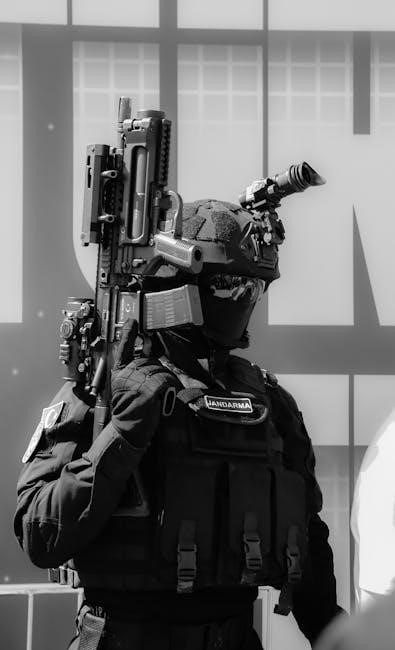
Future Directions in Armored Warfare
Next-generation armored vehicles will integrate AI, autonomous systems, and advanced propulsion, enhancing lethality, mobility, and survivability, while addressing global trends in modern land warfare dynamics.
Next-Generation Armored Vehicles
Next-generation armored vehicles are being developed with cutting-edge technologies to enhance survivability, lethality, and operational adaptability. These vehicles feature advanced propulsion systems, AI-driven autonomous capabilities, and modular designs to meet evolving battlefield demands. Active protection systems (APS) and adaptive armor are integrated to counter anti-tank missiles and other threats. Network-centric warfare capabilities enable seamless communication and coordination between units. Additionally, these vehicles incorporate hybrid powertrains for improved fuel efficiency and reduced logistical burdens. The focus is on creating versatile platforms that can operate effectively in diverse environments, from urban warfare to open terrain, ensuring superiority in future land warfare scenarios while maintaining operational sustainability and strategic flexibility.
AI and Autonomous Systems in Land Warfare
AI and autonomous systems are revolutionizing land warfare by enhancing decision-making, situational awareness, and operational efficiency. These technologies enable real-time data analysis, predictive maintenance, and adaptive tactics, allowing forces to respond swiftly to dynamic threats. Autonomous vehicles, such as unmanned ground systems, reduce risks to personnel while performing reconnaissance, logistics, and combat tasks. AI-driven systems improve target acquisition, fire control, and mission planning, ensuring precision and lethality. Additionally, AI enhances training through advanced simulations, preparing soldiers for complex scenarios. While ethical and operational challenges remain, the integration of AI and autonomous systems promises to transform land warfare, enabling more agile and effective military operations in the future.
Global Trends in Armored Tactics Development
Global trends in armored tactics development focus on enhancing mobility, lethality, and survivability through advanced technologies. Modern armored units prioritize active protection systems, lightweight composite armor, and network-centric warfare capabilities. The integration of unmanned systems and AI-driven platforms is reshaping traditional tactics, enabling autonomous reconnaissance and precision strikes. Nations are also investing in hybrid propulsion systems to improve fuel efficiency and operational range. Additionally, there is a shift towards modular designs, allowing armored vehicles to adapt to diverse mission requirements. These advancements reflect a global emphasis on maintaining technological superiority and operational flexibility in an increasingly complex and dynamic battlefield environment.
The evolution of land warfare armored tactics reflects a continuous adaptation to technological advancements and shifting battlefield dynamics. From the inception of tanks in World War I to the integration of AI and autonomous systems today, armored warfare has transformed to emphasize speed, surprise, and precision. Modern armored tactics prioritize combined arms operations, logistical efficiency, and the use of advanced C4ISR systems. As asymmetric threats and urban warfare challenges emerge, armored units must remain agile and innovative. The future of armored warfare lies in next-generation vehicles, autonomous platforms, and global collaboration to address evolving threats. This balance of tradition and innovation ensures armored tactics remain central to modern military strategy.
